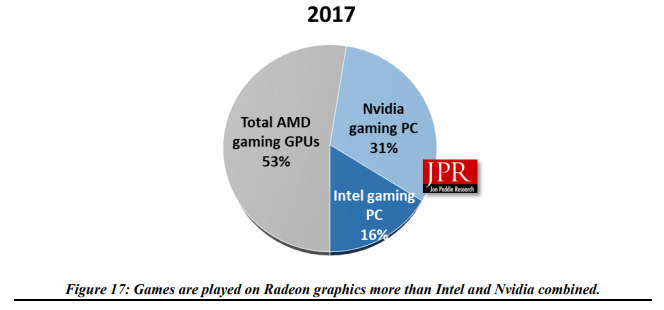I had to chuckle at some false assumptions obviously held by some folks these days: He who dominates the benchmark "news" pages among tech sites does not automatically sell more GPUs than He who makes the GPUs that don't. nVidia's "ray tracing" isn't "real-time ray tracing" at all--it's not even close, actually. How many tech sites understand what ray-tracing is well enough to explain that to their readers? Very few to none at all, it would seem. It looks like far more GPU customers in the market understand these things than the pundits who write about them!
Apparently, as the GPU market continues to mature, people become increasingly jaded about "new features" that actually are not as advertised at all, and so sparsely represented in games so as to be practically invisible. The number of people who buy $1400 GPUs to play 3d games --$1400 GPUs that well might be outclassed in only a few months and usually always are--is a very, very teeny-tiny percentage of all of those people who buy 3d GPUs at any given time. It's like Apple Macs these days--they sell 5% of the annual PC market globally--and yet manage to get 30% of the publicity, sometimes more. It doesn't help them increase their share, though--which has remained static for decades at an eternal ~5%. Microscopic. Secondly, people shopping for GPUs look for more than mere frame-rate contests--because most people can't tell the difference between a stutter-free 60 fps and a stutter-free 120 fps, and, truthfully, could care less. But the difference between $400 and $1400 is readily apparent to them! Shouldn't have to be said as every bit of this is just common sense.
Also, I find it interesting that as neither nVidia or Intel win any console GPU/CPU contracts (of course, nVidia has no CPU to offer), and haven't for many years, that some want to pretend that AMD's console iGPU sales somehow don't exist--when they are strictly based on last-gen x86 PC architectures shipped in some AMD-powered PCs!...😉 So, OK, why do some even want to count Intel iGPUs which are not competitive as 3d accelerators with much of anything made and shipped by AMD and nVidia? That does not compute at all. Intel should not be portrayed at all, imo, since Intel is currently 100% non-competitive in terms of the global discrete 3d GPU markets. Intel has no presence there--yet some want to rank Intel in the mix as well as if there's no difference between what Intel sells and what AMD and nVidia are selling. Some folks are in dire need of new thinking caps, imo...😉



